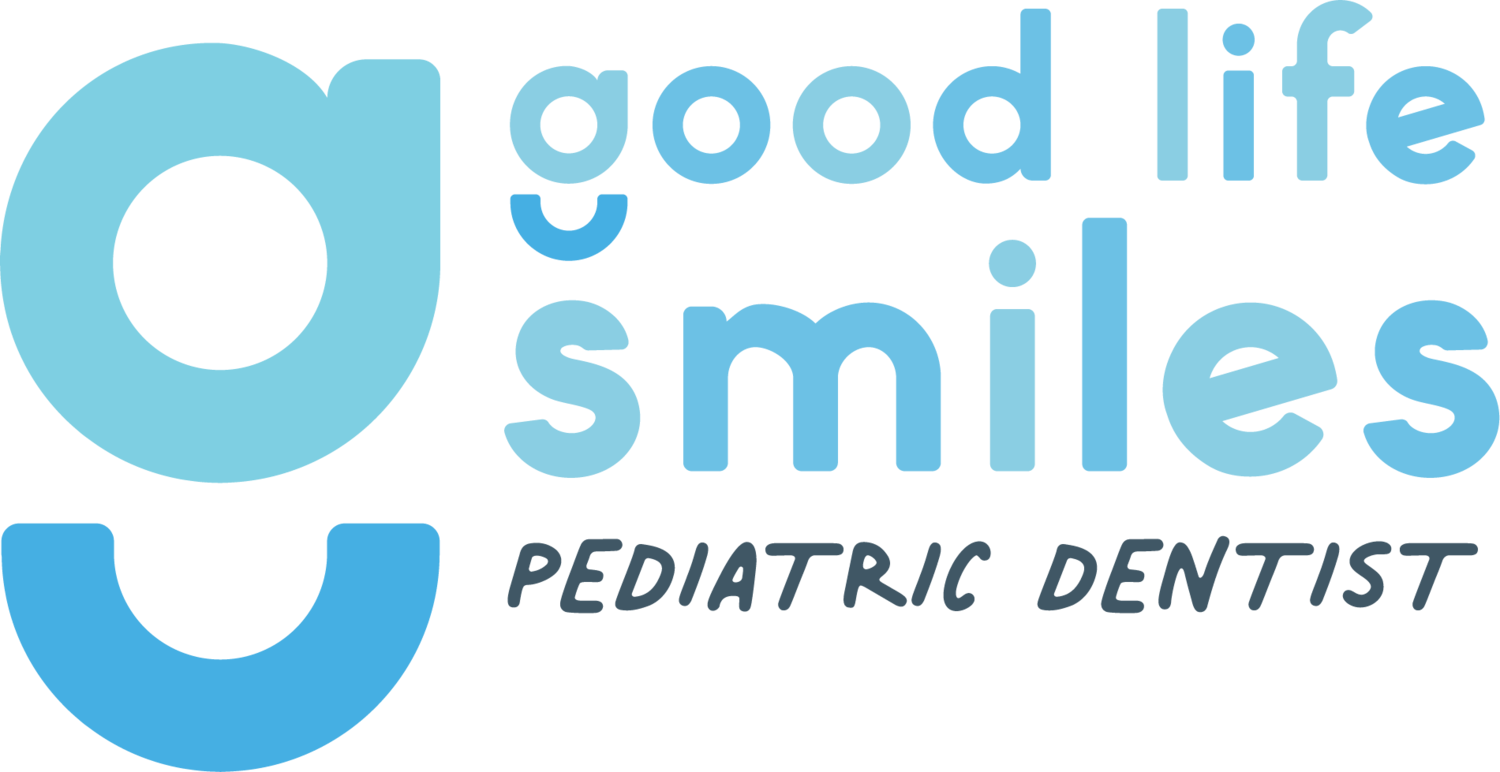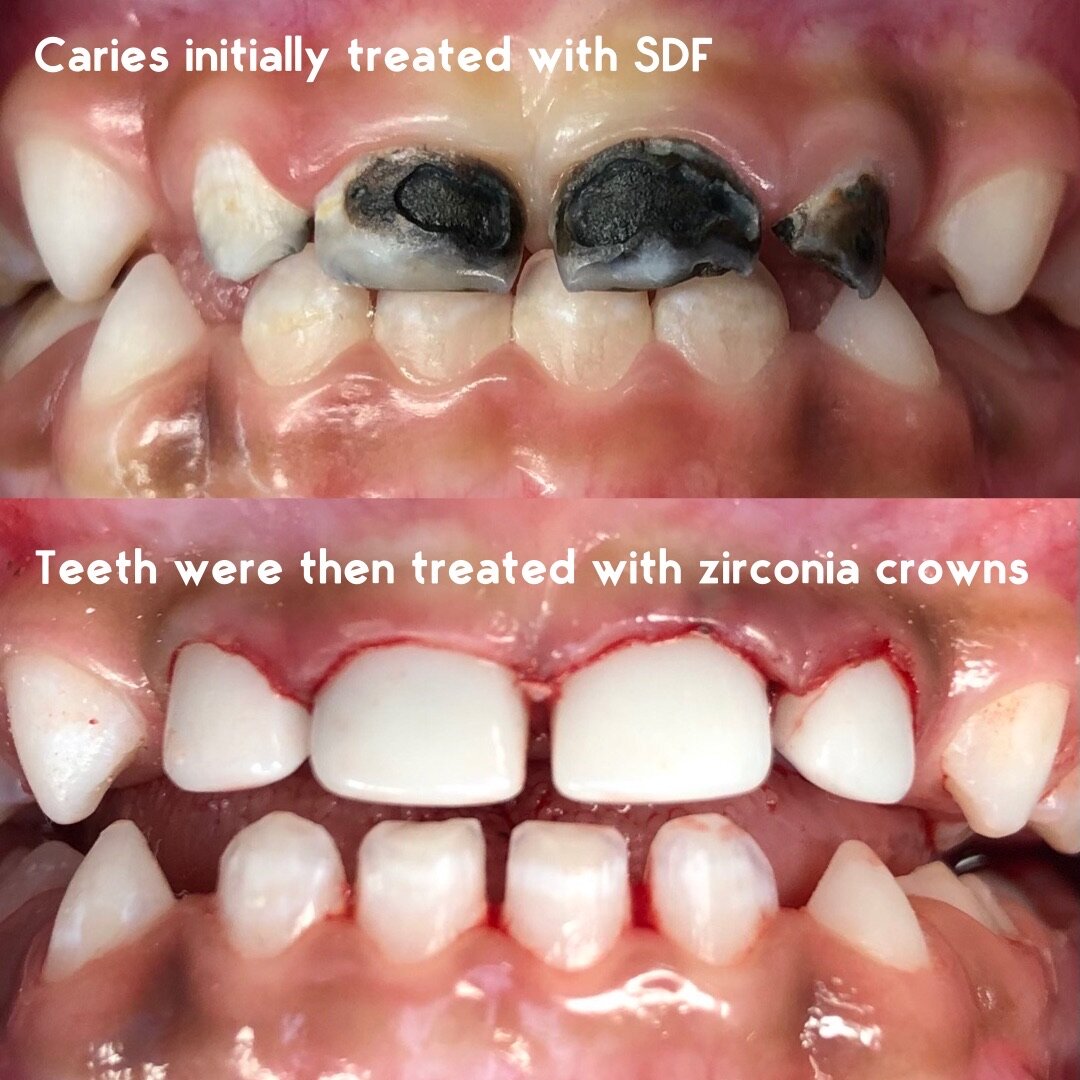
Anticipatory Guidance for the Age 1 Dental Visit
Wondering when kids should first visit the dentist? The AAPD recommends that all kids establish a dental home by their first birthday (or within six months of their first tooth coming in). Click here to refer a patient for their first dental visit!
At Good Life Smiles, our first visit with patient typically lasts between 45 minutes and 1 hour. Most of that first visit is spent educating grown-ups on making mouth-healthy choices. Topics we discuss include oral hygiene instruction and dietary counseling, injury prevention and emergency protocols, nonnutritive sucking habits, and speech/language development.
Oral Hygiene
brushing and flossing
Grown-up assisted toothbrushing should begin as soon as the teeth erupt using a rice-grain sized amount of fluoridated toothpaste on a soft-bristled toothbrush. As soon as kids turn 3, grown-ups can use a pea-sized amount of toothpaste. See the attached image!
Assisted toothbrushing should continue until kids are 6-8 years of age, when they can tie their own shoes. Click here for assisted brushing techniques! Dr. Pete recommends a period of monitored brushing until kids establish a good routine of effective twice daily toothbrushing.
Flossing should be encouraged when teeth begin to touch and can no longer be adequately cleaned with a toothbrush alone.
Dietary Counseling
bottle feeding and dental caries
Frequent bottle feeding at nighttime, breastfeeding on demand, and extended or repetitive use of a no-spill (sippy) cup are associated with Early Childhood Caries (ECC).
Picture attached: the 2-year-old child was going to sleep nightly with a bottle of juice. Teeth were initially treated with silver diamine fluoride (SDF) to arrest caries and strengthen affected dentin. The teeth were then treated with preformed zirconia crowns.
Injury Prevention
Practitioners should provide age-appropriate injury prevention counseling for orofacial trauma. Initially discussions should include play objects, pacifiers, car seats, and electrical cords. The greatest incidence of trauma to primary teeth occurs at 2 to 3 years of age, when children become increasingly mobile and develop coordination.
Accidents do happen, and practitioners are encouraged to have after-hours emergency call protocols in place. Click here for treatment recommendations for primary tooth injuries and permanent tooth injuries.
Nonnutritive Sucking Habits
Early use of pacifiers and digit sucking may be considered normal. Pacifier use through 12 months of age has even been recommended by the American Academy of Pediatrics (AAP) to reduce Sudden Infant Death Syndrome (SIDS). Early dental visits provide an opportunity to encourage parents in helping their children to discontinue nonnutritive sucking habits by age 3. A majority of children will discontinue the habit once they begin preschool.
Intraoral appliance therapy to manage oral habits is indicated only when less invasive techniques have been unsuccessful, the child has a desire to discontinue the habit, and the child would benefit from a reminder device. The products below are a better place to start.
Try this first!
Gentle persuasion and positive reinforcement should be the first line of intervention. Behavior modification can be successful!
ella+mila Nail Care, No More Biting is a bitter-tasting, clear fingernail polish that can serve as a reminder for children not to put their fingers in their mouth. It is often recommended by pediatric dentists as a non-invasive treatment option. It is available on Amazon.com ($10.50 for a 0.45 oz bottle).
Because toddlers eat with their fingers, bitter-tasting nail polish may lead to food aversions! Dr. Pete recommends discontinuing the nail polish if toddlers begin to refuse their favorite healthy foods.
Another good option
TGuard AeroThumb (or AeroFinger for digit suckers) is a highly effective device that prevents thumbsucking altogether.
This option is a little more expensive at $50 per glove … and kids may need one for each hand (for a total of $100) if they beat the system and suck an un-TGuarded thumb. Try discount code tguardworks for 10% off.
Bonus! TGuard guarantees results in 4 weeks or patients get their money back.
Speech and Language Development
Click here for a list of speech and language milestones for kids from birth to five years-old.
For kids who need a little help with speech and language skills, Dr. Pete recommends speech pathologist Heather Kanago, who uses play-based therapy techniques and gives real-world “homework” assignments. Heather is also specialized in Augmentative and Alternative Communication (AAC) Therapy and utilizes a combination of no-tech, low-tech, mid-tech, and high-tech devices to match patient’s specific communication needs. Heather is wonderful with kids of all abilities, and speech therapy sessions can be scheduled in the patient’s home or school.
References
American Academy of Pediatric Dentistry. Speech and Language Milestones. The Reference Manual of Pediatric Dentistry. Chicago, IL: American Academy of Pediatric Dentistry; 2021: 573-4.





